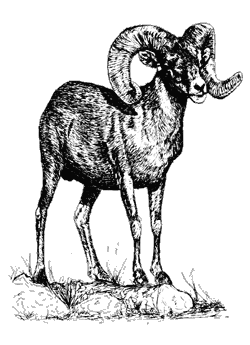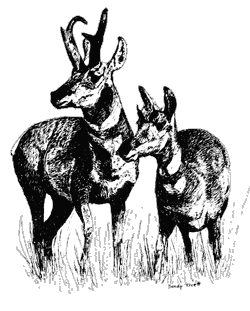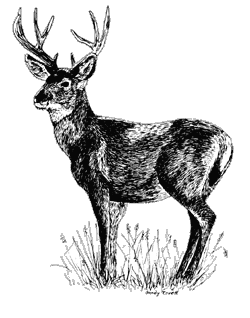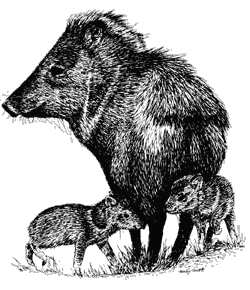Hooved Animals
The Sonoran Desert is home to 4 species of hooved animals—javelina, mule deer, pronghorn, and bighorn sheep. Hooves are specialized claws or toenails, adaptations for running to escape predators. Hooved animals, also called ungulates, are usually herbivores that socialize in herds or bands. Living in a group benefits all the individuals, since there are many sets of eyes watching for predators.

|
Javelina are common throughout the Sonoran Desert region. Any area with sufficient prickly pear and other cacti can be home to a herd of javelina. They usually provide plenty of evidence of their presence, such as chewed prickly pear pads, rooted-up areas around plants, and many trails and bed grounds.
Our other three hooved desert animals are ruminants (even-toed, cud-chewing animals). Mule deer inhabit the lower foothills and brushy canyons in the desert, while white-tailed deer live at the higher elevations in the mountains. Mule deer depend mainly on good hearing and eyesight, camouflage, and running for defense. Their large (9 inch; 23 cm) ears move continually, checking antennae-like for any sounds of danger. The main predator of deer is the mountain lion.
Pronghorn populations are not large anywhere in Arizona. The Sonoran pronghorn is listed as endangered, but herds in a few places—the Buenos Aires Wildlife Refuge is one—are doing well.
Bighorn sheep numbers have also declined due to human encroachment and competition with domestic sheep and wild burros, but reintroduced populations are increasing in numbers. The construction of artificial waterholes in some areas has helped maintain bighorn herds.
Sonoran Desert species:
javelina, collared peccary (Tayassu tajacu)
mule deer (Odocoileus hemionus)
pronghorn (Antilocapra americana)
bighorn sheep (Ovis canadensis)
Order: Artiodactyla
Family: Tayassuidae (javelina), Cervidae (deer), Antilocarpidae (pronghorn), Bovidae (bighorn, and, formerly, pronghorn)
Spanish names: jabalí, cochi javelín (javelina), venado buro (mule deer), berrendo (pronghorn), borrego cimarrón, chivo cimarrón (bighorn)
Distinguishing Features

|
Javelina: The javelina is a medium-dog-sized animal of about 40 to 55 pounds (18-25 kg), that somewhat resembles a small wild boar. It has a coarse salt and pepper pelage, short legs, and a distinctly pig-like snout. The head appears to join the shoulders with very little neck. A collar of lighter-colored hair rings the neck and shoulders. Both males and females have long, sharp canines, the “javelins” for which they are named.
Click to hear Javelina foraging sounds
Click to hear a variety of Javelina sounds
Click to hear Javelina teeth clacking
Mule deer: This is a brownish-grey deer with big ears like a mule’s, and a white rump patch; its small white tail has a black tip. Only the buck grows antlers, which are shed each spring and regrown during the summer and fall. The main beam of the antlers diverges into 2 branches, each bearing 2 or more tines.
Pronghorn: The pronghorn is a medium-deer-sized animal with long, thin legs, a large white rump patch, and white on the sides of its face. Both males and females have forked or pronged horns that are shed each year, except for a small inner core.
Bighorn sheep: The desert bighorn is a heavy-bodied, gray-brown, deer-sized animal with a large white rump patch. Both males and females have horns, but the males’ are much larger, growing into a curled spiral shape over the course of several years.
Habitat
Javelina are common throughout the Arizona Upland. They favor saguaro-palo verde forests, and grasslands with mixed shrubs and cacti, but make use of other habitats as well.
Mule deer are widespread throughout the desert areas wherever there is sufficient vegetation for browse and cover. They make elevational migrations in the foresummer and winter.
Pronghorn are grassland animals, preferring open areas with rolling hills and a few shrubs.
Bighorn sheep are found in rugged, rocky desert mountain ranges and some canyons. They prefer precipitous slopes and cliffs where they can be safe from predators.
Feeding
• Diet: These hooved animals are all herbivores. Javelina eat roots, tubers, seeds, mesquite beans, green vegetation, cactus fruits, agaves, and prickly pear pads. When the opportunity presents itself, they will also eat dead birds or rodents. Mule deer browse on mesquite leaves and beans, catclaw, jojoba, buckbrush, and fairy duster, and graze on a variety of forbes and grasses. Pronghorn feed on grasses and forbes but also browse on globemallow, brickellia, sagebrush, rabbitbrush, and other shrubs.
Bighorn sheep eat many different grasses as well as mesquite leaves and beans, desert lavender, fairy duster, desert ironwood, palo verde, globe-mallow, cactus fruits and agave.

|
• Behavior: Javelina meander in loose groups, feeding as they move through an area. They dig up roots and bulbs with their sharp hooves or with their snouts. They eat prickly pear cacti, spines and all, by tearing off bites with their large canines. Because they don’t have sharp cutting teeth, much fibrous material is left on the prickly pear. Javelina chew as they walk, so bits and pieces fall from their mouths, sometimes leaving a short trail.
Mule deer usually eat early in the mornings and in the evenings, and are sometimes active on moonlit nights. They both browse and graze.
Bighorn sheep feed early in the mornings and again late in the afternoons. A sheep sometimes kicks the top off a barrel cactus to reach the succulent inside, or butts its horns against a saguaro to get at the tender flesh.
Life History
Javelina live in groups of 2 to 20 animals, the average being about 8 to 12. Each group defends a territory of about 700 to 800 acres, the size and boundaries varying in different seasons and different years; the territories include bed grounds and feeding areas, but they may overlap at critical resources, especially watering holes. An older, experienced sow leads the herd, determining when to bed down, feed, or go to water. Javelina have no defined breeding season; the babies, usually twins, can be born in any month. Not many predators other than a mountain lion will attack an adult javelina, but the babies are also prey for coyotes, bobcats, and other animals.
Javelina have poor vision, relying instead on their sense of smell. (See sidebar, next page.)
The mule deer breeding season occurs in December and January, but the one or two fawns are not born until the next summer rainy season, about seven months later. The does often move higher on the mountains into more rugged terrain to drop their fawns, so as to avoid coyote predation. The little fawns are up and able to run within a few days after birth. They usually remain with the mother until the next year. Most deer spend their lives within a 1 or 2 square mile home range.
Pronghorn are well adapted to living in open areas of little cover. Instead of hiding from predators, they rely on their large eyes and exceptionally good vision to spot predators from up to 4 miles away! They are the fastest runners in North America, attaining speeds of 35 to 40 miles per hour. Pronghorn run with their mouths open in order to gulp extra oxygen to supply their large hearts.
Bighorn sheep live in and around the most inaccessible steep canyon walls and rugged terrain. Their defense is to retreat to these hard-to-reach spots where predators cannot follow.
Bighorn feed with their herds early in the morning, bedding down to rest near each other in shallow caves or thick brush, while they chew their cuds. Activity resumes in the late afternoon. Breeding occurs during August and September. Rams butt heads to establish dominance and the right to breed, and the cracking sound of their butting heads can be heard a mile away.
The ewes move off alone to drop their lambs in February, rejoining the group about a week later with the new lamb. Lambs imprint on the spot where they were born, and try to return there when they are ready to give birth.
Both males and females have horns. The ewe’s horns are narrow and only grow about 12 inches (30 cm) long (about a half curl). The male’s horns are broad and massive and eventually curl in nearly a full spiral. The ram’s horns may weigh as much as 40 pounds (18 kg)!
No Way Out
I was walking up a deep, dry arroyo bottom north of Phoenix a few years ago. As I rounded a corner, I came face to face with a doe and two fawns, having unintentionally “chased”them up the narrow canyon. Behind the deer the arroyo ended abruptly in a vertical rock wall at least fifteen feet high. The doe trotted toward me a few steps, judged that the cut was too narrow to safely pass by me, then turned and bolted back toward the rock wall. I stepped to one side of the arroyo, hoping she would pass by, but instead she ran towards the wall and easily ascended it. I watched her disappear in amazement, then moved further aside to encourage the fawns to pass back down the arroyo rather than attempt such a foolhardy exit. But they had other plans. In turn, they bolted for the wall and deftly surmounted it. I walked over to the wall, looked up, and judged that no matter how much I might want to follow those deer, there was no way I could do so without running the risk of serious bodily harm. I was forced to retrace my steps and find an easier way to move upstream. As I walked down the arroyo I realized that this was truly mule deer habitat; I was but a visitor.
Bighorn: Adapted for Desert Living
Bighorn sheep inhabit some of the driest mountain ranges in Arizona—they are superbly adapted to life in these arid environments. During winter months when dew is available and plants contain more moisture, the sheep can last for several months without drinking free water. In the intense heat of summer when most green plants have dried up, they seek out barrel cactus, chain fruit cholla fruits, and other cactus fruits for their water content. They avoid the sun by resting in the shade or in caves and shallow overhangs, but they can withstand body temperatures of up to 107°F (42°C)! (Normal body temperature for bighorn sheep is 101 to 102°F; 38 to 39°C.) Enlarged stomach compartments can store water to last for several days, allowing the sheep to go 2 or 3 days without a drink. They can then drink up to 20 percent of their body weight (up to 2 gallons; 7.5 liters) in just a few minutes at a waterhole.
Peccary Perfume
Usually hidden beneath the bristly hairs near the rear of a javelina’s back is a small organ producing an oily liquid with a strong and unmistakable odor. This musky perfume helps maintain order in the busy javelina social life.

|
Javelina usually stay with the same herds throughout their lives, traveling, feeding, bedding down, even playing together. From time to time pairs of animals stand nose-to-tail and rub their heads across each other’s scent glands. As a result of this frequent contact, every javelina herd develops its own distinctive group scent.
Javelina sniff each other to recognize their herd-mates. As the herd moves through the desert it’s enveloped by its communal smell, helping members to stay in contact with the group. (They also listen for the sounds of the other animals’ grunting, chewing, and moving about.)
Odor also helps keep different herds apart. Herds mark the boundaries of their territories by rubbing scent glands across rocks and trees.
Arizona-Sonora Desert Museum Book of Answers (Desert Museum Press, 1998)